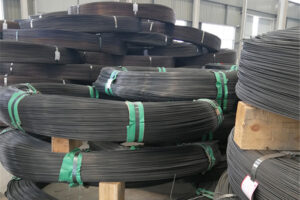2.1 Basic Properties Required for Spring Steel
 As a professional manufacturer of Torsion Springs,Extension Springs,Compression Springs,Die Springs,Circlips,Wire Forming. We need to know the Basic Properties Required for Spring Steel,which will benifit to our spring quality.We hereby wish to introduce such information basically as follow,
As a professional manufacturer of Torsion Springs,Extension Springs,Compression Springs,Die Springs,Circlips,Wire Forming. We need to know the Basic Properties Required for Spring Steel,which will benifit to our spring quality.We hereby wish to introduce such information basically as follow,
(1) High Strength:
To meet the requirements of energy-saving and lightweight design in mechanical engineering, the spring steel used should have high tensile strength and yield strength while maintaining plasticity and toughness. Tensile strength is closely related to the chemical composition of the steel, microstructure, heat treatment techniques, cold working (such as cold drawing or cold rolling) deformation, and other factors. For example, the tensile strength of cold-drawn carbon spring steel wire increases with higher carbon content. In the case of hypoeutectoid steel (such as 65M), the lower the proeutectoid ferrite content and the smaller the pearlite lamella spacing, the higher the tensile strength of the drawn raw material and the final product. As for the materials used in the production of quenched and tempered spring steel wire, higher silicon content results in higher tensile strength, such as 55CrSi having significantly higher tensile strength compared to 50CrVA.
(2) High Yield-to-Strength Ratio:
The working characteristics of a spring determine the need for high elastic deformation capacity, which is reflected in the performance parameter of higher yield strength without compromising plasticity. Generally, as the tensile strength of steel increases, so does its yield strength. However, since the tensile strength of steel cannot be infinitely increased, it is desirable to maximize the yield strength within a limited range of tensile strength, i.e., improving the yield-to-strength ratio of the steel.
The yield-to-strength ratio is closely related to the chemical composition of the steel, microstructure, heat treatment techniques, cold working deformation, and other factors. It is an important research topic in the steel industry. Currently, the maximum yield-to-strength ratio for quenched and tempered low-alloy spring steel wire can reach 92%.
(3) Good Plasticity:
During the spring manufacturing process, the material undergoes various degrees of deformation, requiring it to have a certain level of plasticity. This requirement is particularly strict for cold forming processes. For example, for complex-shaped tension and torsion springs, the curvature radius is often very small, causing intense plastic deformation in localized areas. In such cases, the material’s plasticity must meet stringent requirements.
(4) Good Toughness:
Finished springs need to withstand dynamic or static loads and potentially uncertain impact loads. If the material lacks sufficient impact toughness, the reliability of the spring cannot be guaranteed.
(5) Excellent Resistance to Relaxation:
The resistance to relaxation of a spring, also known as elastic decay resistance, refers to its ability to resist plastic deformation when subjected to long-term dynamic or static loads in a working environment. The resistance to relaxation of a spring mainly depends on the steel’s chemical composition and strengthening methods. For example, higher silicon content in quenched and tempered spring steel results in higher resistance to relaxation. Therefore, improving the effects of solid solution strengthening, precipitation hardening, and fine-grain strengthening by adjusting the alloy element type and content can enhance the resistance to relaxation. Different processing techniques have different strengthening mechanisms, which also affect the resistance to relaxation. Springs made from quenched and tempered steel wire exhibit significantly higher resistance to relaxation compared to those made from cold-drawn steel wire.
(6) Excellent Surface Quality:
The surface of a spring bears the highest stress during operation, and in most cases, fatigue failure is caused by surface defects. If the material surface contains cracks, folds, pits, roughness, scratches, or indentations, these defects can create stress concentration points during spring operation, leading to fatigue fracture. Moreover, if severe decarburization occurs on the surface, particularly a thick layer of complete decarburization, it can reduce the effectiveness of shot peening and cause fatigue cracks to form first in the decarburized surface layer, thus reducing the fatigue life of the spring. Therefore, strict control of decarburization is crucial. In actual production processes, for important applications requiring high fatigue requirements, such as valve springs, suspension springs, and clutch springs, stripping or polishing processes are generally used to improve surface quality by removing a layer of material from the surface, eliminating minor defects and non-severe decarburization. For a small number of significant defects, the position can be identified using eddy current testing and removed during subsequent spring manufacturing processes. During spring heat treatment, protective atmosphere heating can be employed to prevent surface decarburization and oxidation.
(7) High Fatigue Life:
The fatigue life of a spring is a comprehensive assessment indicator. It is greatly influenced by the steel’s chemical composition and its degree of segregation, metallographic structure, grain size, non-metallic inclusion content and distribution characteristics, tensile strength, yield strength, sectional shrinkage, elongation, surface quality, spring manufacturing processes (such as heat treatment, shot peening, surface soft nitriding), stress levels, stress amplitude during service, load nature, and assembly quality. Therefore, strict control is required at each stage of spring production.
(8) High Dimensional Accuracy:
Many springs have high requirements for load accuracy, such as valve springs that should not deviate more than 5% to 6% from the specified load. Taking tension and compression springs made from round steel wire as an example, a 1% diameter deviation in the wire can cause approximately 4% load deviation. Therefore, high dimensional accuracy is essential for spring quality.
(9) Good Uniformity:
Material uniformity mainly refers to the consistency of chemical composition, mechanical properties, dimensional deviations, and roundness, with minimal fluctuations. When there are significant differences in various indicators of the material, it can lead to increased variability in geometric dimensions, hardness, load, and other parameters of the spring, and in severe cases, generate a large amount of scrap.






